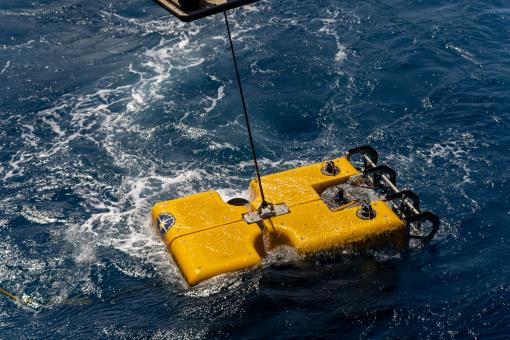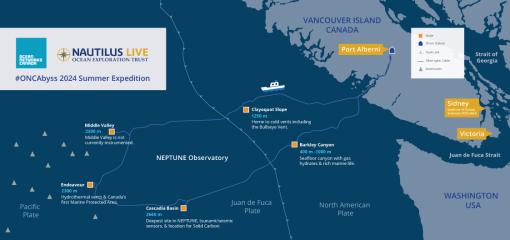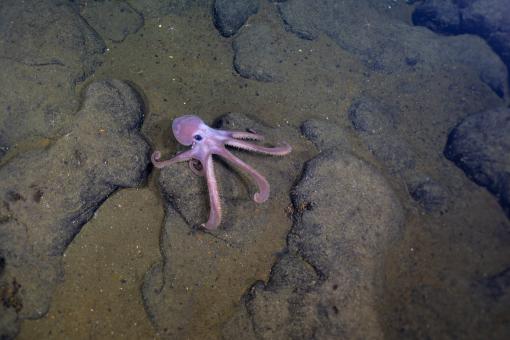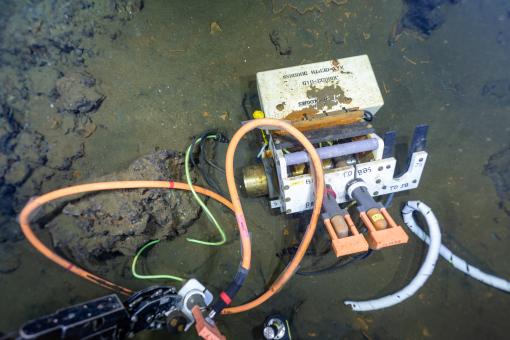Ocean Exploration Collaboration to Explore and Demystify Deep Sea Habitats Off British Columbia

Ocean Exploration Trust and Ocean Networks Canada team up for the eighth year of exploring and maintaining NEPTUNE cabled observatory in Northeastern Pacific Ocean.
The Ocean Exploration Trust (OET) and Ocean Networks Canada (ONC) sets sail today on the NA161 #ONCabyss Summer 2024 expedition to service and maintain ONC’s world-leading 800+ kilometer (500+ mile) subsea cabled observatory network and, importantly, to visit the Endeavour hydrothermal vent field for the first time since a swarm of earthquakes was detected there off British Columbia’s coast in early March. This expedition, sponsored by Ocean Networks Canada, brings OET’s Exploration Vessel (E/V) Nautilus to the Northeast Pacific Ocean for our eighth year of partnership with ONC, an initiative of the University of Victoria which operates observatories on the three coasts of Canada and the Southern Ocean.
The main objective of the 21-day expedition (departing from Sidney, British Columbia) is deploying, recovering, and maintaining a wide range of sensors and instruments connected to ONC’s biggest observatory, the North-East Pacific Time-series Undersea Networked Experiments (NEPTUNE) - a fiber optic cable-based observatory that hosts thousands of sensors connected at five key sites, starting off the west coast of Vancouver Island and stretching to the mid-ocean Juan de Fuca Ridge and back.

“ONC is excited to once again be partnering with its OET and E/V Nautilus to support our annual maintenance expedition of the NEPTUNE cabled ocean observatory. A relationship of operational, engineering and communications excellence built over the previous seven expeditions together has set us up on this 8th expedition to work efficiently and effectively while executing complicated and delicate operations, such as a 3 km-long secondary cable lay that requires a complex two-ship operation to precisely place it in 2660m of water,” says ONC Director of Observatory Digital Operations Meghan Paulson. “We are looking forward to testing out advancements in camera and mapping technology that have been incorporated into Hercules when we visit the Endeavour Hydrothermal Vent Marine Protected Area to investigate increased earthquake activity over the past several months. We may see newly formed seafloor, captured in high definition over 2 km underwater.”
The expedition team onboard E/V Nautilus will use remotely operated vehicles (ROVs) Hercules and Atalanta to deploy and recover observatory sensors, cameras, and instruments and provide general maintenance at NEPTUNE–navigating the deep seain one of the most hostile environments on Earth. The team will also assist in scientific seafloor surveys with biological and geological sampling, investigating unique coastal marine life and deep sea ecosystems, including the spectacular Endeavour hydrothermal vent field.
In March 2024, ONC’s real-time monitoring network detected a peak of more than 200 earthquakes per hour at Endeavour. Over approximately eight days of the expedition, the team will complete both servicing of the scientific instruments as well as research dives, potentially providing new insight into changes to the seafloor resulting from the ongoing tectonic activity. In addition to visiting the Endeavour site, the expedition team plans to visit four other sites including an ongoing photogrammetry project at a whale fall located near the Clayoquot Slope site.
“This is OET’s eighth expedition with ONC since 2015, and we’re thrilled to be working alongside such great partners again this June.” says OET Chief Operating Officer Allison Fundis, “Our collaboration allows us to combine our expertise and technologies to tackle challenging operations associated with the maintenance of ONC’s world-leading subsea cabled observatory and to also broadly share our work and discoveries with those joining us from shore. We are particularly excited to explore the recent seismic activity at Endeavour, which could reveal fascinating insights into the interplay between tectonics and deep-sea ecosystems. ”
The Summer 2023 partnership expedition between OET and ONC was highlighted by 20 ROV dives to complete maintenance throughout NEPTUNE, during which we collected 114 samples to support ongoing temporal studies on ocean processes across ONC’s observatory sites. Additionally, we mapped 3,811 square kilometers of seafloor in priority areas identified by Fisheries and Oceans Canada.

E/V Nautilus expeditions are made available to the public in real-time through live-streamed video on NautilusLive.org, a 24-hour portal bringing expeditions from the field to people on shore via telepresence technology. Viewers can ask the at-sea OET and ONC team questions via the website and follow expeditions with behind-the-scenes updates on social media. In addition to the live-streamed video, science communicators and STEAM professionals will connect directly to classrooms via free educational Q&A interactions from the onboard broadcast studio.
As one of Canada’s leading major research facilities, ONC collects continuous live and long-time series data from its cabled, mobile, and community-based observing networks that are openly available for researchers, decision-makers, and anyone with an interest in the deep ocean. NEPTUNE delivers thousands of observations about how the ocean is changing across an entire tectonic plate and beyond with high-resolution temporal observations not possible using traditional ship-based exploration. This ocean data enables advances in scientific discovery, marine safety, earthquake detection and notification, and ocean-based climate change mitigation.
“The E/V Nautilus is a purposely outfitted ship ideally tailored for ocean exploration and to conduct the complex deep ocean operations that ONC must conduct to ensure that we keep our thousands of sensors delivering data for scientific research, societal protection, and advancing Canada’s blue economy,” says Kate Moran, President and CEO of Ocean Networks Canada. “Although I won’t be onboard, I’ll be able to feel as I were because of the real-time telepresence. I invite anyone with Internet connectivity to join me to be onboard with us virtually.”

Building upon decades of study, stewardship, and discoveries, OET remains committed to the open sharing of data collected during these expeditions. Mapping and ROV operations in unexplored areas will directly contribute to the US National Strategy for Ocean Mapping, Exploration, and Characterization, the Ocean Networks Canada Strategic Plan, and multi-national development of a global high-resolution seafloor map by Seabed 2030, and the UN Decade of Ocean Science for Sustainable Development.
As E/V Nautilus visits the Eastern Pacific Ocean, we acknowledge the First Nations and Indigenous communities of the Northeast Pacific, particularly the Nuu-chah-nulth people who have stewarded through generations the ocean, seas, coastlines, and lands of what is known as the Pacific Ocean. We honor and respect the enduring deep relations and interconnections that exist between these peoples, the ocean, and the environment. Ocean Exploration Trust is committed to building connections with local communities in expedition regions through co-developing expedition plans, making data publicly accessible, and coordinating outreach with schools and community groups.
